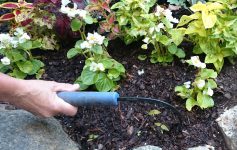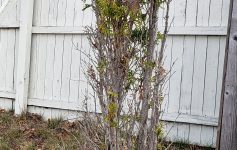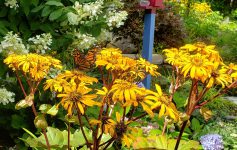My lawn and gardens are now covered with leaves as a result of this week’s high winds and rain. As I drive through towns I see piles of leaves lining the side of the streets. Eventually those leaves will make their way to the landfill or a composting area. At my house we have no seasonal leave removal services. So I have learned how to put leaves to work for me by feeding my garden soil. You may want to take a second look at disposing your leaves and consider the “value of leaves” as an organic gardening additive. According to the Old Farmers Almanac, the leaves of one large tree can be worth as much as $50.00 in plant food and humus. They are a source of calcium, magnesium, phosphorous, potassium and trace minerals tree roots have mined from the ground. It has been found that leaves actually contain twice the mineral content of many gardener’s favorite soil additive: manure. The inherent organic matter can offer improvement to your soil structure. Adding it to clay soil can lighten it, while adding to sandy soil can increase moisture retention. When you purchase soil additives like community based compost, farmers manure and commercially manufactured retail you really don’t know what goes into that additive. Managing your home property, you know first hand the practices you apply to your landscapes. So you can be assured of the chemical/disease-free content of your leaf compost. Leaves are sitting right there on your property ready for your use and they are free! And let’s face it, who passes up free stuff?
The trick to making your leaves work for you is how you manage them in the Fall. Although my lawn growth slows down with the cooler temps…we continue to run our mower across the lawn weekly to chop up the leaves and combine with grass trimming. As more leaves fall, we blow loose piles onto the lawn and again use our mower to chop up. Our leaf vac also chops up the leaves nicely. Chopped leaves decompose quicker. If their are no grass clippings in my chopped leaves (a great source of nitrogen) I top dress with a nitrogen based granular fertilizer to help feed bacteria that will further break down the leaves.
There are many ways to use leaves to jump start your gardens next spring. I use them as a light cover on my strawberry patch, layer in my herb/veggie garden after removing the seasonal plants, use as a fall mulch layer in my perennial gardens and layer in areas I want to restore/create new next season. I have a really troublesome spot in my front property that is plagued with poor soil, roots and winter salt spray. Over the years adding my brown gold each fall, the area has become a sustainable planting area for low maintenance gardens. Heavy snow fall will provide the weight and moisture to assist the leaf decomposition rate. It has taken time and patience, but the value of leaves has been well demonstrated in my seasonal garden displays. Maybe you want to think twice before bringing all that “free stuff” street side this fall!
As always keeping “common sense and sustainability” firmly rooted in my garden practices.



